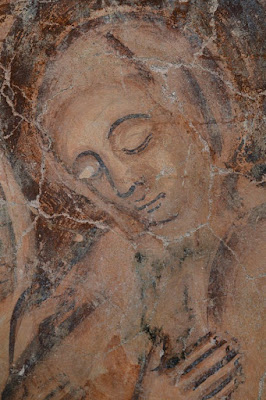 |
| Push conference with Ernő Marosi, József Lángi and Zsombor Jékely (picture: Magyar Kurír) |
The medieval wall paintings of the church have been preserved in the sanctuary. Their existence experienced been recognised for some time, and their existence underneath later layers of plaster was recognized in 2001. Numerous facts had been uncovered by restorer József Lángi in 2012, which led to a approach for their finish recovery. When the group of the church was also convinced of the value of these frescoes, work could commence with the help of the Rómer Flóris Program. In September – Oct 2019, the whole surface of the sanctuary wall has been cleaned and wall paintings have been uncovered on the northern and southern wall of the sanctuary, as well as all around the eastern home windows.
 |
| Passion cycle on the northern wall of the sanctuary |
The ensemble recovered by József Lángi is fragmentary: a large Late Gothic window opened in the southern wall wrecked a significant portion of the wall paintings. The vaults collapsed (most very likely in 1717) and had been replaced by a flat ceiling – as a result a extremely essential element of the former ensemble is missing. A 19th-century gallery mounted in the sanctuary for an organ induced even more destruction. In spite of all this, a remarkably full cycle of wall paintings has occur to light. The northern and southern wall of the sanctuary was embellished with a detailed Christological cycle, narrating the story of Christ from the Annunciation by the Passion all the way to the dying and Coronation of the Virgin Mary.
 |
| Massacre of the Innocents |
The floor of the wall paintings however requires to be cleaned and they will need to be restored – a undertaking which can ideally be finished all through the upcoming two decades. In the meantime, we can by now establish that the fresco cycle was painted for the duration of the second portion of the reign of King Sigismund (1387-1437) – most probable in the 1420s. No other is effective are regarded by the same workshop in the Higher Tisza Valley, so the discovery of these frescoes is a significant addition to our understanding about medieval portray in north-eastern Hungary. Artwork historical analysis on the fresco cycle will start in the in close proximity to foreseeable future, and hopefully, original outcomes will be revealed before long.
You can browse much more about the push conference (in Hungarian) in this overview by Magyar Kurír. To master far more about the medieval churches of the area, have a search at the web page of the Route of Medieval Church buildings. Shots in the put up are by Attila Mudrák.











